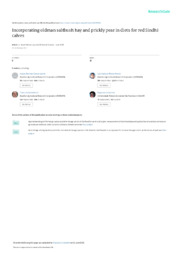Incorporating oldman saltbush hay and prickly pear in diets for red Sindhi calves.
Incorporating oldman saltbush hay and prickly pear in diets for red Sindhi calves.
Author(s): ALVES, J. N.; ARAUJO, G. G. L. de; PEREIRA, L. G. R.; GONZAGA NETO, S.; MENEZES, D. R.; VOLTOLINI, T. V.; GOIS, G. C.; SOUZA, L. C.; CAMPOS, F. S.
Summary: This study was designed to evaluate the nutrient intake, digestibility, degradability, and ruminal characteristics of Sindhi heifers fed diets that contained a combined total of 75% oldman saltbush hay (hereafter saltbush hay) and prickly pear cactus. Eight 12-month old intact male red Sindhi calves (four fistulated and four non-fistulated) with an initial mean weight of 170 ± 5 kg were assigned to 4 × 4 Latin squares, where factors consisted of four diets, namely 15% hay and 60% cactus; 30% hay and 45% cactus; 45% hay and 30% cactus; and 60% hay and 15% cactus, and four times at which rumen fluid was collected. Neutral detergent fibre (NDF) and acid detergent fibre (ADF) intakes in kg/day and NDF in percentage live weight (LW), water intake, salinity, and conductivity increased with hay level. Intake and digestibility of nonfibrous carbohydrates were curvilinear with higher values in diets containing 30% saltbush hay. The apparent digestibility of dry matter (DM) and organic matter decreased linearly as the concentration of saltbush hay increased in the diet. The pH of the rumen fluid was within the acceptable range for favourable microbial growth. The low temperature and high salinity and conductivity indices in the diets should be viewed with caution at higher concentrations of saltbush hay, because of a possible decrease in nutrient absorption and the development of health problems in the animals. Apparent degradability coefficients of DM and NDF were affected significantly by inclusion of prickly pear and saltbush hay in the diets.
Publication year: 2020
Types of publication: Journal article
Unit: Embrapa Semi-arid Region
Observation
Some of Embrapa's publications are published as ePub files. To read them, use or download one of the following free software options to your computer or mobile device. Android: Google Play Books; IOS: iBooks; Windows and Linux: Calibre.
Access other publications
Access the Agricultural Research Database (BDPA) to consult Embrapa's full library collection and records.
Visit Embrapa Bookstore to purchase books and other publications sold by Embrapa.

